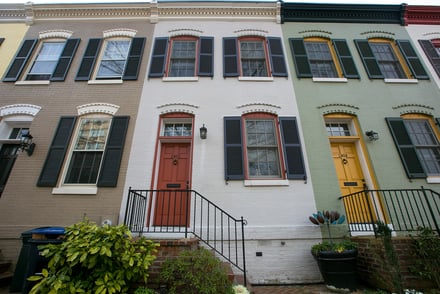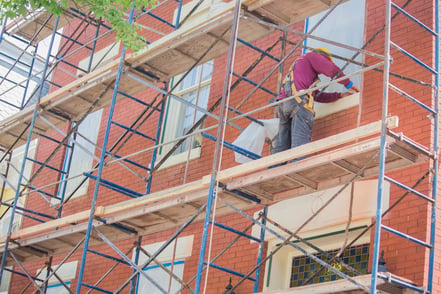Brick and mortar structures are considered to be among the most weatherproof and long-lasting buildings. And yet, older brick and mortar homes and businesses will need periodic repairs. Weather will erode these dated bricks and soft mortar, allowing moisture intrusion that will create even more damage over time.
Winter is especially hard on your brick façade due to the constant moisture and freezing temperatures. Water that can get into or behind your brick façade freezes and expands, causing cracks and breakage. Washington, DC winters, in particular, can be harsh and unforgiving with resulting water damage. When the elements begin to erode your brick and mortar outdoor façade, it's time for some professional tuckpointing to restore the beauty and integrity to your home or business.
What is Tuckpointing?
Tuckpointing, often called repointing, removes damaged or deteriorated mortar from between bricks and replaces it with a lime-based, breathable mortar. This older style mortar allows for moisture evaporation and prevents water from evaporating through the older, softer bricks, which causes discoloration.
Replacing the mortar also closes the possible entryways for moisture that can cause extensive damage. Exterior residential tuckpointing should be part of regular maintenance on any masonry wall. It's a good practice to inspect your brick façade for water damage each year, preferably in the spring. Older home or business owners with brick and mortar facades should also budget for some possible tuckpointing every five to ten years.
Do I Need Full or Spot Tuckpointing?
Full tuckpointing is the process of removing and replacing all the mortar from between the bricks of your home or business. This is a method of restoration to improve the integrity and increase the longevity of your structure. It is conducted one section at a time to maintain structural integrity. If your brick home or business was built before the early twentieth century, you should consider having your structure evaluated for a complete tuckpointing.
Spot tuckpointing is the process of repointing on a smaller scale. It involves repairing only sections of damaged mortar, such as open holes or large settling cracks. It is basically just plugging up holes to prevent more water intrusion and staving off a full-scale tuckpointing. Renaissance Development is your area tuckpointing specialist that can evaluate the damage to your brick and mortar building and make repairs.
How to Tell If Your Brick Facade Needs Tuckpointing
Renaissance Development suggests performing the following actions to determine if your brick façade needs tuckpointing after a harsh winter.
1. Examine the brick visually. Look for visible signs of wear like cracks or places with missing mortar.
2. Also, look for mortar that seems recessed further into the brick than surrounding areas, allowing water to pool on the brick edges.
3. Take a key or pencil and scrape at the mortar. If it flakes into power or crumbles easily, the mortar is deteriorated and needs tuckpointing.
4. If you see a white powdery substance on the brick, efflorescence, you may have a moisture problem.
If you find visible signs of deterioration or want a more professional eye to evaluate the condition of your brick and mortar, call us at Renaissance Development.
Renaissance Development, a leader in brick restoration and historic preservation, specializes in the restoration of a historic brick building’s mortar joints using traditional methods (tuckpointing) and materials. Contact us for a free site visit and project quote.
12/20/19 5:25 PM


